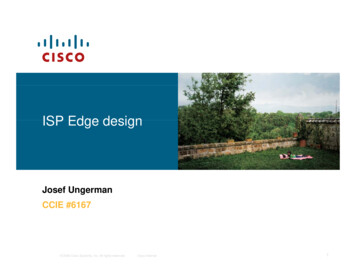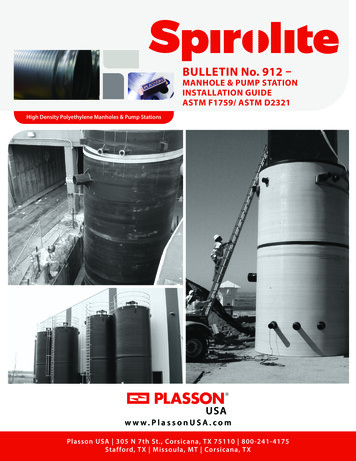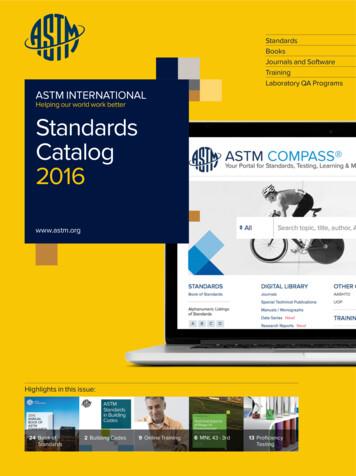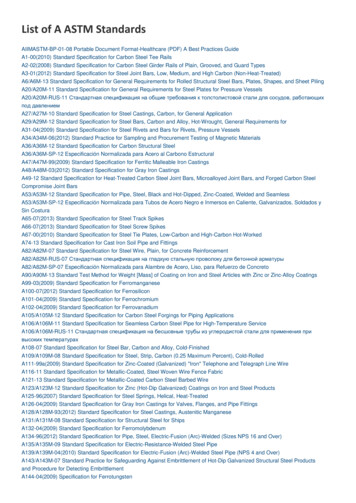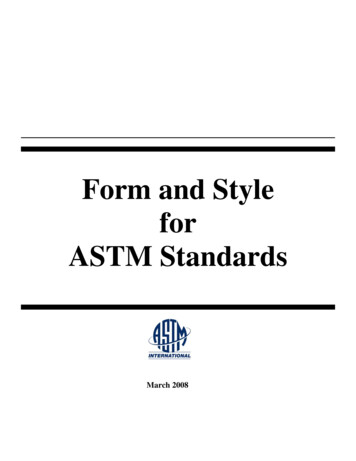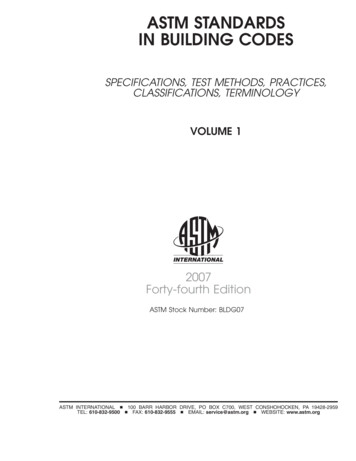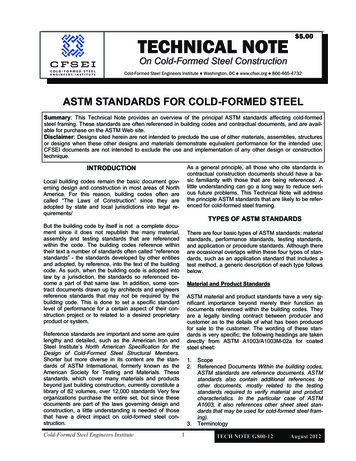
Transcription
Standards: The Corporate EdgeA Handbook for the Busy ExecutiveHelen Delaney
Table of ContentsPart OneIntroduction. vA Word About Language. viiChapter One: The BasicsMyths. 1Company Standards. 2Industry Standards. 3The Process. 4Volunteers . 6Back to the Process. 6Full Consensus Standards. 7The Technical Committee. 7Chapter Two: Tricks of the TradeBarriers to Trade. 9Design vs. Performance. 10Governments. 10International Standards. 11Consensus. 11Multinationals. 12Back to International Standards. 12Back to Governments. 13Review. 14The Most Important Statement in this Book. 15Chapter Three: Working the System: SDOsProfile: National Standards Body A. 17Profile: National Standards Body B. 17Profile: European Standards Bodies. 18Access and Influence. 18Profile: The United States. 18The International Standards Developing Organization A. 19The International Standards Developing Organization B. 19Chapter Four: Helpful Hints Or Interesting Topics for ConversationsWith Your Technical StaffThe Three Rs: Relevance, Redundancy, and Religion. 21Relevance. 21Redundancy. 21Religion. 22Strategize. 22Lobbying. 22Quality. 22 ASTM International 2007iiiwww.astm.org
Part TwoA Corporate Executive’s ViewStandards – How to Break the Love – Hate CycleLaura Hitchcock, The Boeing Company. 23Part ThreeStandards Organizations. 31Profile: National Standards Bodies A. 31Table 1. National Standards Bodies A. 31Profile: National Standards Bodies B. 32Table 2. National Standards Bodies B. 32Profile: European Standards Bodies. 33Table 3. European Standards Bodies. 33Profile: The United States. 34Table 4. U.S. Private Sector Standards Developing Bodies. 34Table 5. U.S. Government Agencies. 35Profile: The International Standards Developing Organization A. 35Table 6. International Standards Developing Organizations A. 35Profile: The International Standards Developing Organization B. 36Table 7. International Standards Developing Organizations B. 36 ASTM International 2007ivwww.astm.org
IntroductionStandards are too important to bethe exclusive preserve of technical experts.In more ways than one, this statement by the European Commission signaled the end of an age of innocence thathad lasted approximately one hundred years. Almost overnight, the technical, virtually invisible activity withincompanies known as standardization moved up the corporate ladder and into the executive suite. Only one thingcould have driven it there: the power to generate profit.Standardization might have lived forever in obscurity but for an event that changed the way the world didbusiness: a call by a group of governments for a worldwide reduction in tariffs. The marketplace, like nature,abhorred the vacuum. It responded with a new competitive device: technology. Standards. In no time, standardization, like an understudy waiting in the wings, stepped out of obscurity and onto the world stage.What is a standard, exactly? It has been defined as an agreed upon way of doing something. Standards are skillfully constructed tools of industry and commerce. They are technology in real time, living documents possessed with limitless versatility. Standards may define products, set their characteristics, parameters, or levelsof performance. They may prescribe production processes, or they may be methods by which products aretested. Standards may be the specifications in a contract, or they may be a sign, a known quantity that signifiesintegrity. They are a language of trade used by buyers and sellers. They are passports to world markets. They areregulations. Standards, when they are very good, are synonymous with quality and market relevance. Standardscan impart safety to products and interchangeability to parts. Standards are references, weights, and measures.They make the pieces fit. They are states of the art, technological achievements that are beyond calculations ofworth. Standards are the corporate edge.This is not a handbook for those whose interest in standards is academic. It is not for technical experts. Theyalready know what standardization is about. This handbook is for people in business. It is for people for whomtime is money; and so, it is short and simple. Also contributing to this book is author, Laura Hitchcock, who is acorporate executive from one of the greatest companies in the world. For that reason alone, she is worth listening to.Above all, this handbook is about the way today’s markets are won or lost with standards, about high-tech competition and strategy, and how it is formed, not by salesmen, but by scientists. Green Paper on The Development of European Standardization: Action for Faster Technological Integration in Europe,COM(90)456, 8 October 1990. The General Agreement on Tariffs and Trade (GATT) of 30 October 1947. The GATT 1994 established the World Trade Organization. ASTM International 2007vwww.astm.org
A Word About LanguageAs in any other field, people in standardization communicate with each other in their own language. It isn’tdifficult, it isn’t complicated, and, outside of a technical committee, it isn’t technical. It’s colloquial. For instance, standards are not “set”. They are developed. People who develop standards are participants. Sometimes they are called “stakeholders”, but participants is the term more commonly used.Sometimes the word standard is used as an adjective, i.e., a standard specification or a standard test method.In this handbook, colloquial terms will be italicized, and if their meaning is not obvious, they will be translated.This handbook is dedicated to Barbara Schindler, whose idea it was, and to Laura Hitchcock, whotook time - a most precious commodity - to contribute to this handbook, my deepest thanks. ASTM International 2007viiwww.astm.org
Chapter One: The BasicsStandardization is unimaginably technical, as is computer science. Yet, the laptop has become the indispensable,ubiquitous corporate accessory. And every executive knows all he or she needs to know about the irreplaceablecomputer; and that’s how to use it. It’s a tool. Nothing more. And so is standardization.This handbook has one main objective. It is to introduce standardization as a tool, a corporate function thatwill get the company out in front. It is not necessary to understand everything about it to make it work for thecompany. One does not have to be an engineer or a mechanic to drive a car.MythsBefore going to the facts, let’s review some of the myths surrounding standardization. Here are just four:The most widespread myth is that Standardization is boring. The truth is this: nothing that increases marketshare is boring.This is a good one: Trade is regulated by the best, most up-to-date standards. Nonsense. Trade policies arebased on exporting more and importing less. Standards are used to accomplish this goal. They’re never used tohelp the competition, even when they’re better. Especially when they’re better.This is commonly heard: International standards are the answer to barriers to trade. Question: Whathappens when they become a barrier to trade? They can.This may be the most damaging to a company: Standardization should be delegated to the EngineeringDepartment and left alone. They know what to do. But they don’t know what you want to do if you don’ttell them. They need to know the company’s strategy. And you need to know what they’re doing when they go tothose standards meetings.What follows is fact. ASTM International 20071www.astm.org
2DelaneyCompany StandardsA company standard is in
ASTM International 2007 www.astm.org Introduction Standards are too important to be the exclusive preserve of technical experts. I n more ways than one, this statement by the European Commission1 signaled the end of an age of innocence that had lasted approximately one hundred years. Almost overnight, the technical, virtually invisible activity within

